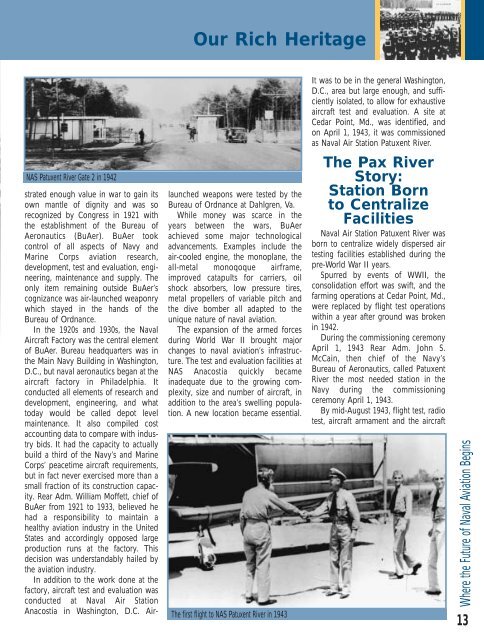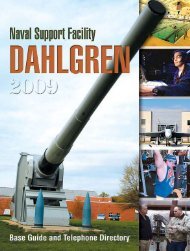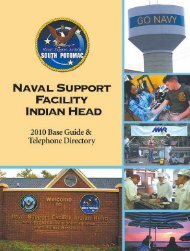About Naval Air Station Patuxent River - DCMilitary.com
About Naval Air Station Patuxent River - DCMilitary.com
About Naval Air Station Patuxent River - DCMilitary.com
You also want an ePaper? Increase the reach of your titles
YUMPU automatically turns print PDFs into web optimized ePapers that Google loves.
NAS <strong>Patuxent</strong> <strong>River</strong> Gate 2 in 1942<br />
strated enough value in war to gain its<br />
own mantle of dignity and was so<br />
recognized by Congress in 1921 with<br />
the establishment of the Bureau of<br />
Aeronautics (BuAer). BuAer took<br />
control of all aspects of Navy and<br />
Marine Corps aviation research,<br />
development, test and evaluation, engineering,<br />
maintenance and supply. The<br />
only item remaining outside BuAer’s<br />
cognizance was air-launched weaponry<br />
which stayed in the hands of the<br />
Bureau of Ordnance.<br />
In the 1920s and 1930s, the <strong>Naval</strong><br />
<strong>Air</strong>craft Factory was the central element<br />
of BuAer. Bureau headquarters was in<br />
the Main Navy Building in Washington,<br />
D.C., but naval aeronautics began at the<br />
aircraft factory in Philadelphia. It<br />
conducted all elements of research and<br />
development, engineering, and what<br />
today would be called depot level<br />
maintenance. It also <strong>com</strong>piled cost<br />
accounting data to <strong>com</strong>pare with industry<br />
bids. It had the capacity to actually<br />
build a third of the Navy’s and Marine<br />
Corps’ peacetime aircraft requirements,<br />
but in fact never exercised more than a<br />
small fraction of its construction capacity.<br />
Rear Adm. William Moffett, chief of<br />
BuAer from 1921 to 1933, believed he<br />
had a responsibility to maintain a<br />
healthy aviation industry in the United<br />
States and accordingly opposed large<br />
production runs at the factory. This<br />
decision was understandably hailed by<br />
the aviation industry.<br />
In addition to the work done at the<br />
factory, aircraft test and evaluation was<br />
conducted at <strong>Naval</strong> <strong>Air</strong> <strong>Station</strong><br />
Anacostia in Washington, D.C. <strong>Air</strong>-<br />
Our Rich Heritage<br />
launched weapons were tested by the<br />
Bureau of Ordnance at Dahlgren, Va.<br />
While money was scarce in the<br />
years between the wars, BuAer<br />
achieved some major technological<br />
advancements. Examples include the<br />
air-cooled engine, the monoplane, the<br />
all-metal monoqoque airframe,<br />
improved catapults for carriers, oil<br />
shock absorbers, low pressure tires,<br />
metal propellers of variable pitch and<br />
the dive bomber all adapted to the<br />
unique nature of naval aviation.<br />
The expansion of the armed forces<br />
during World War II brought major<br />
changes to naval aviation’s infrastructure.<br />
The test and evaluation facilities at<br />
NAS Anacostia quickly became<br />
inadequate due to the growing <strong>com</strong>plexity,<br />
size and number of aircraft, in<br />
addition to the area’s swelling population.<br />
A new location became essential.<br />
The first flight to NAS <strong>Patuxent</strong> <strong>River</strong> in 1943<br />
It was to be in the general Washington,<br />
D.C., area but large enough, and sufficiently<br />
isolated, to allow for exhaustive<br />
aircraft test and evaluation. A site at<br />
Cedar Point, Md., was identified, and<br />
on April 1, 1943, it was <strong>com</strong>missioned<br />
as <strong>Naval</strong> <strong>Air</strong> <strong>Station</strong> <strong>Patuxent</strong> <strong>River</strong>.<br />
The Pax <strong>River</strong><br />
Story:<br />
<strong>Station</strong> Born<br />
to Centralize<br />
Facilities<br />
<strong>Naval</strong> <strong>Air</strong> <strong>Station</strong> <strong>Patuxent</strong> <strong>River</strong> was<br />
born to centralize widely dispersed air<br />
testing facilities established during the<br />
pre-World War II years.<br />
Spurred by events of WWII, the<br />
consolidation effort was swift, and the<br />
farming operations at Cedar Point, Md.,<br />
were replaced by flight test operations<br />
within a year after ground was broken<br />
in 1942.<br />
During the <strong>com</strong>missioning ceremony<br />
April 1, 1943 Rear Adm. John S.<br />
McCain, then chief of the Navy’s<br />
Bureau of Aeronautics, called <strong>Patuxent</strong><br />
<strong>River</strong> the most needed station in the<br />
Navy during the <strong>com</strong>missioning<br />
ceremony April 1, 1943.<br />
By mid-August 1943, flight test, radio<br />
test, aircraft armament and the aircraft<br />
Where the Future of <strong>Naval</strong> Aviation Begins<br />
13

















